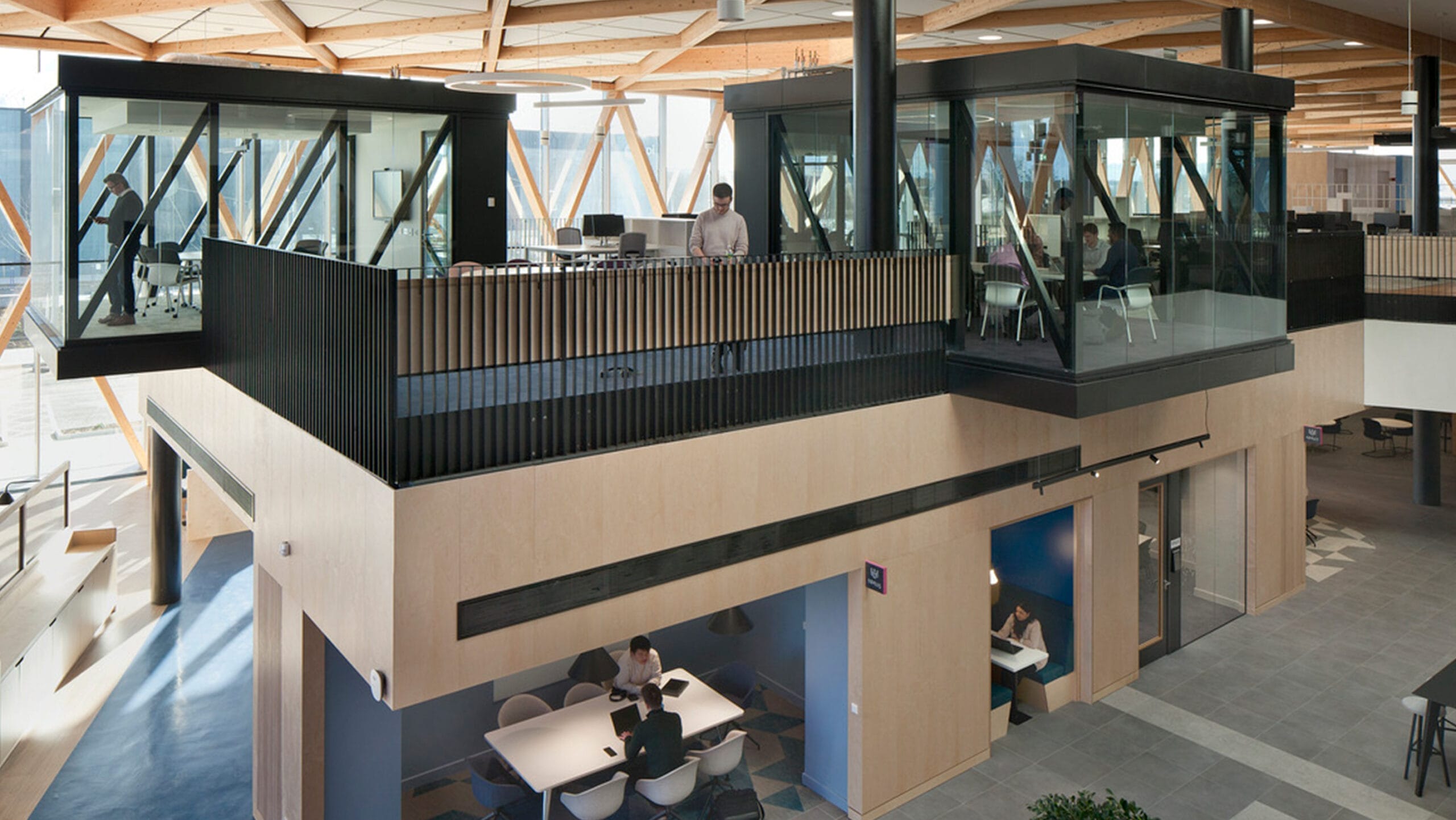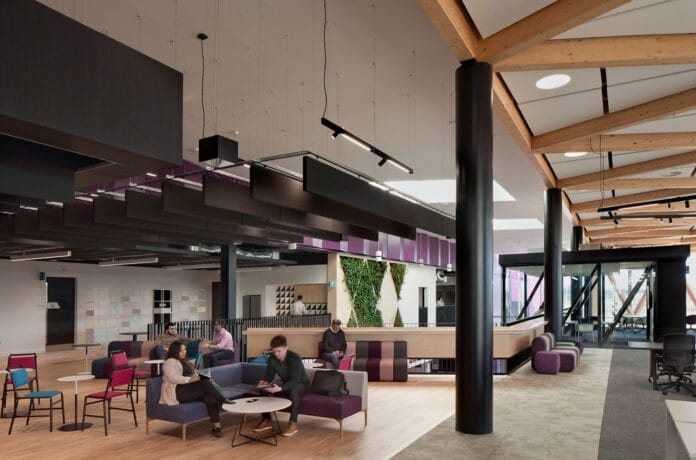
In his article, originally written as part of a study by the University Design Forum Research Group, Director and Head of Design, Philip Watson talks about the opportunities that innovation districts offer our cities and how Universities can kick-start, anchor and curate innovation hub places to support research, education, collaboration and entrepreneurship.

The key elements of innovation districts still apply over a decade after Bruce Katz defined them in his work for the Brookings Institution with his seminal article, “The Rise of Innovation Districts,” written with Julie Wagner. His early definition of innovation districts has never been surpassed:
“Innovation districts constitute the ultimate mash-up of entrepreneurs and educational institutions, start-ups and schools, mixed-use development and medical innovations, bike-sharing and bankable investments—all connected by transit, powered by clean energy, wired for digital technology, and fuelled by caffeine.”
Katz talks about the key elements of what these districts want and need which include:
- Partnerships: A diverse group of both public and private institutions, companies and people all totally committed to the project.
- People: Firms want to be near their competitors and enjoy direct connections to universities and collaborative spaces that promote creativity.
- Place: The design of space needs to promote walking, biking, and human interaction, and has a ‘hip’ and attractive vibe.
Imagine a new model for how we organise our communities. Not just places of work, but rich and appealing neighbourhoods, where people live and relax too. These districts need to be physically compact, transit accessible, and technically wired; offering a mix of workshops, labs, office, mixed-use housing, bars, restaurants, coffee shops and retail.
Most major cities throughout Europe have at least one innovation district under development, however a number of towns and cities are falling into the trap of recreating traditional ‘Science Parks’ that are missing the opportunity to exploit their full potential. Increasingly, students, academics and researchers want to live in urban communities, preferring to walk or cycle rather own a car, and they want to live in an exciting neighbourhood that can support their needs within walking distance.
The “anchor plus” model, primarily found in downtown regeneration areas, is where large scale mixed-use development is centred around major anchor HE institutions and a rich base of related firms, entrepreneurs and spin-off companies involved in the commercialization of innovation. “Anchor plus” is best exemplified by Kendall Square in Cambridge, Massachusetts where the explosion of growth around innovation has improved ideas, products, services, technologies, and processes – creating new market demand and cutting-edge solutions to economic, social and environmental challenges.



In the UK, a good example of a successful innovation district would be the emerging ‘Knowledge Quarter’ within the regeneration area of Kings Cross – a partnership of 66 knowledge-based institutions in the mile-wide neighbourhood around King’s Cross, Bloomsbury and Euston.
The Knowledge Quarter itself spans a multitude of new sectors and the Francis Crick Institute is creating a focal point for medical and life sciences research, while the arrival of the Alan Turing Institute is creating a new national hub for data science. Tileyard Studios and Kings Place provide dynamic centres for music, while Central Saint Martins has helped transform the area into a creative cluster. And it’s also hard to overstate the impact the arrival of Google will make on the local tech sector with their huge new facility currently under construction alongside organisations such as the Digital Catapult.
It is worth mentioning that the Francis Crick Institute which opened in 2016 is a partnership between Cancer Research UK, Imperial College London, King’s College London, the Medical Research Council, University College London and the Wellcome Trust – a great example of true collaboration.
These new sectors are mixing with industries that have traditionally thrived here: architecture, museums, media, education, publishing and scientific research. The British Library is working with the Alan Turing Institute to strengthen its own data research capacity. The British Museum has enlisted the help of Google to enable digital access to its collections. The Design Council has partnered with MedCity to develop the next generation of user-centred, non-invasive medical technology, and the Wellcome Trust and Arts Catalyst are breaking down barriers between art and science. And universities like UCL are at the forefront of championing interdisciplinary research with outside partners. Industries, institutes and organisations, new and old, large and small, public, private and non-profit, are all coming together to work together to shape the changing economy.
This new wave of open collaboration is seeing tremendous success for start-ups and SME’s bringing cutting edge research to market . It is this cross fertilization between diverse research sectors and clusters that is exciting and inspiring. However, this all takes time. Successful innovation districts have evolved, developed, and grown organically in response to market forces over several years. What we are seeing with the next generation of these districts is a move away from universities controlling and managing development to a model that is driven by commercialisation and organic growth.
The term “Innovation District” is increasingly used in many development projects, but are they any more than a cluster of university buildings built by universities for their own research needs, with limited access for industry partners? The next generation of innovation districts will need to focus on the increasing growth in the commercialization of ideas. What is the pipeline of innovations that can be brought to market? Again the U.S. is probably ahead of Europe in the way they already focus on the commercial value of I.P. and economic growth, with meaningful metrics in place to benchmark job creation, business creation, and investment returns. However, we do need to ask if universities are best placed to develop and manage these facilities? – and whether they are the right vehicle to fully support the start-ups and spin-out companies within them? Should universities become commercial developers of innovation districts, providing the vision, leadership, and funding to nurture their growth – to create the types of places that attract the best minds and talent as well as stimulate their local and regional economies?
Partnerships like the Knowledge Quarter in Kings Cross can give organisations which are geographically close a sense of shared purpose, not just by encouraging collaboration, but by connecting them with their communities. Here they have already launched a number of projects to ensure local residents can benefit from the resources of their partners, from raising the aspirations of local children to launching an apprenticeship scheme for young people in the borough of Camden.
Clearly, HE institutions have a key role to play in the success of innovation districts. How can we collectively ensure that this opportunity is maximized?



